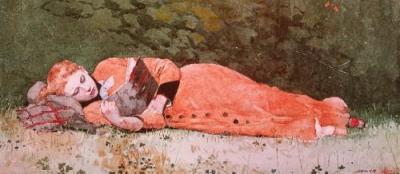Sicherman (2002) Notes
Sicherman, Barbara. "Reading and Middle-Class Identity in Victorian America." Reading Acts: U.S. Readers' Interaction with Literature, 1800-1950. Eds. Barbara Ryan and Amy M. Thomas,. Knoxville: University of Tennessee Press, 2002. 137-160.
Mary Austin's comments on need for high culture, reading of the best books, etc., in 1870s; cf. Bourdieu (137).
Critique of Frankfurt School model of passive consumption of popular culture: Radway on metaphor of consumption (138). Consumption of cultural goods as means to complete the self, McCracken (139).
To examine Victorian America, culture of reading seen as noble, self-improving; and as agent of middle class identity or, to empower the move into the middle class (139).
 Abundance
of books after 1850. Winslow Homer, "The New Novel" (see right; link).
Various distribution systems, including Sears catalogue, etc. (140). Cheap
publications, dime novels that included George Eliot, Charlotte Bronte, etc.
(141). Value in creating emerging middle class (141), reading distinguishes
the cultured (142). Moral improvement of reading, even of novels (142-3):
"sacralizing of culture", as in Arnold (143). Growing respectability of fiction,
but for the young must be monitored (143): "to reinforce middle-class norms"
(144).
Abundance
of books after 1850. Winslow Homer, "The New Novel" (see right; link).
Various distribution systems, including Sears catalogue, etc. (140). Cheap
publications, dime novels that included George Eliot, Charlotte Bronte, etc.
(141). Value in creating emerging middle class (141), reading distinguishes
the cultured (142). Moral improvement of reading, even of novels (142-3):
"sacralizing of culture", as in Arnold (143). Growing respectability of fiction,
but for the young must be monitored (143): "to reinforce middle-class norms"
(144).
Example of reading development in Kansas, William Allen White (144-5) [cf. Radway]. But control of young people's reading, fear of corruption, planting "the seeds of robbery and lust" (146).
Bourdieu vs. Chartier on equating class with reading (147). Diffusion of high cultural reading among working class (147). Reading as "self-culture" (148), or completing the self (149).
Appropriation of books, interpreting in non-orderly ways (149). [how do we know?]
Reading across gender lines: although women read much fiction, other kinds of texts were also read, acted as agents of transformation (150). Example of Carey Thomas (150-1).
And reading to learn about others, across class boundaries, creating affinity with other classes of people (151).
Later decline of reading -- between 1890-1930, with advent of consumerist magazines, the radio, etc. (152).